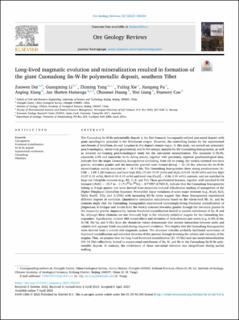Long-lived magmatic evolution and mineralization resulted in formation of the giant Cuonadong Sn-W-Be polymetallic deposit, southern Tibet
Dai, Zuowen; Li, Guangming; Yang, Zhiming; Xie, Yuling; Fu, Jiangang; Xiang, Anping; Huizenga, Jan Marten; Huang, Chunmei; Liang, Wei; Cao, Huawen
Peer reviewed, Journal article
Published version
Permanent lenke
https://hdl.handle.net/11250/3069307Utgivelsesdato
2023Metadata
Vis full innførselSamlinger
Originalversjon
10.1016/j.oregeorev.2023.105434Sammendrag
The Cuonadong Sn-W-Be polymetallic deposit is the first Cenozoic leucogranite-related rare-metal deposit with giant metallogenic potential in the Himalayan orogen. However, controlling factors for the supernormal enrichment of beryllium, tin and tungsten in this deposit remain vague. In this study, we carried out systematic geochronological, whole-rock geochemical, and Sr-Nd isotopic analysis for the Cuonadong leucogranites, as well as detailed ore-forming geochronological analysis. The monazite U-Th-Pb, cassiterite U-Pb and muscovite Ar-Ar dating results, together with previously reported geochronological data, indicate that the major Cuonadong leucogranites (including, from old to young, weakly-oriented two-mica, two-mica granite and muscovite) were formed during ∼21-15 Ma, whereas the Sn-W-Be mineralization mainly occurred at ∼18-14 Ma. The Cuonadong leucogranites show strong peraluminous (A/CNK=1.09-1.22) features, and have high SiO2 (71.62-75.97 wt.%) and Al2O3 (14.04-16.09 wt.%) and low MgO (0.07-0.33 wt.%), MnO (0.01-0.15 wt.%) and total Fe2O3 (0.36-1.01 wt.%) contents, and are enriched in large ion lithophile elements (e.g., Rb, U, K, and Pb). These geochemical features together with enriched Sr-Nd isotopes (εNd(t) = -15.7 to -11.7; (87Sr/86Sr)i=0.71957-0.76313) indicate that the Cuonadong leucogranites belong to S-type granite and were derived from muscovite-induced dehydration melting of metapelites of the Higher Himalayan Crystalline Sequence. Perceptible linear variations of some major elements (e.g., Na2O, K2O, MnO, Fe2O3T, TiO2 and A/CNK) with increasing Rb/Sr ratios suggest these leucogranites experienced different degrees of evolution. Quantitative simulation calculations based on the whole-rock Rb, Sr, and Ba contents imply that the Cuonadong leucogranites experienced increasingly-strong fractional crystallization of plagioclase, K-feldspar and biotite from the weakly-oriented two-mica granite to two-mica granite and muscovite granite. Importantly, intense fractional crystallization leaded to notable enrichment of Sn, W and Be, although these elements are not obviously high in the relatively primitive magma for the Cuonadong leucogranites. Significantly, evident REE tetrad effects and deviation of twin-element pair ratios (K/Rb, K/Ba, Zr/Hf, Nb/Ta, and Y/Ho) from the chondritic values demonstrate that intense interaction between melts and F-rich aqueous fluids occurred during magmatic evolution. This implies that the Cuonadong leucogranites were derived from a volatile-rich magmatic system. The abundant volatiles probably remarkably facilitated and extended the fractional crystallization though lowering the solidus and viscosity of the magma. Thus, we propose that long-lived crystal fractionation (∼21-15 Ma) and mineralization (∼18-14 Ma) collectively leaded to supernormal enrichment of Sn, W, and Be in the Cuonadong Sn-W-Be polymetallic deposit. In contrast, the enrichment of Sn, W, and Be during the partial melting was insignificant.
